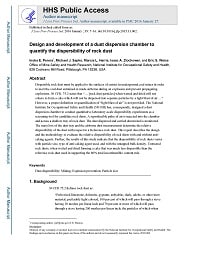Mining Publication: Design and Development of a Dust Dispersion Chamber to Quantify the Dispersibility of Rock Dust
Original creation date: January 2016
Authors: I Perera, M Sapko, ML Harris, IA Zlochower, ES Weiss
Dispersible rock dust must be applied to the surfaces of entries in underground coal mines in order to inert the coal dust entrained or made airborne during an explosion and prevent propagating explosions. 30 CFR. 75.2 states that “… [rock dust particles] when wetted and dried will not cohere to form a cake which will not be dispersed into separate particles by a light blast of air …” However, a proper definition or quantification of “light blast of air” is not provided. The National Institute for Occupational Safety and Health (NIOSH) has, consequently, designed a dust dispersion chamber to conduct quantitative laboratory-scale dispersibility experiments as a screening tool for candidate rock dusts. A reproducible pulse of air is injected into the chamber and across a shallow tray of rock dust. The dust dispersed and carried downwind is monitored. The mass loss of the dust tray and the airborne dust measurements determine the relative dispersibility of the dust with respect to a Reference rock dust. This report describes the design and the methodology to evaluate the relative dispersibility of rock dusts with and without anti-caking agents. Further, the results of this study indicate that the dispersibility of rock dusts varies with particle size, type of anti-caking agent used, and with the untapped bulk density. Untreated rock dusts, when wetted and dried forming a cake that was much less dispersible than the reference rock dust used in supporting the 80% total incombustible content rule.

- Coal Dust Explosibility Meter Evaluation and Recommendations for Application
- Development of an Anti-Caking Rock Dust
- How Does Limestone Rock Dust Prevent Coal Dust Explosions in Coal Mines?
- New Rock Dusting Standard to Prevent Coal Mine Explosions
- NIOSH Hazard ID 16 - Non-Conforming Rock Dust
- Particle Size and Surface Area Effects on Explosibility Using a 20-L Chamber
- Refuge Alternatives in Underground Coal Mines
- Rock Dusting
- Rock Dusting Considerations in Underground Coal Mines
- Technical Development of the Coal Dust Explosibility Meter